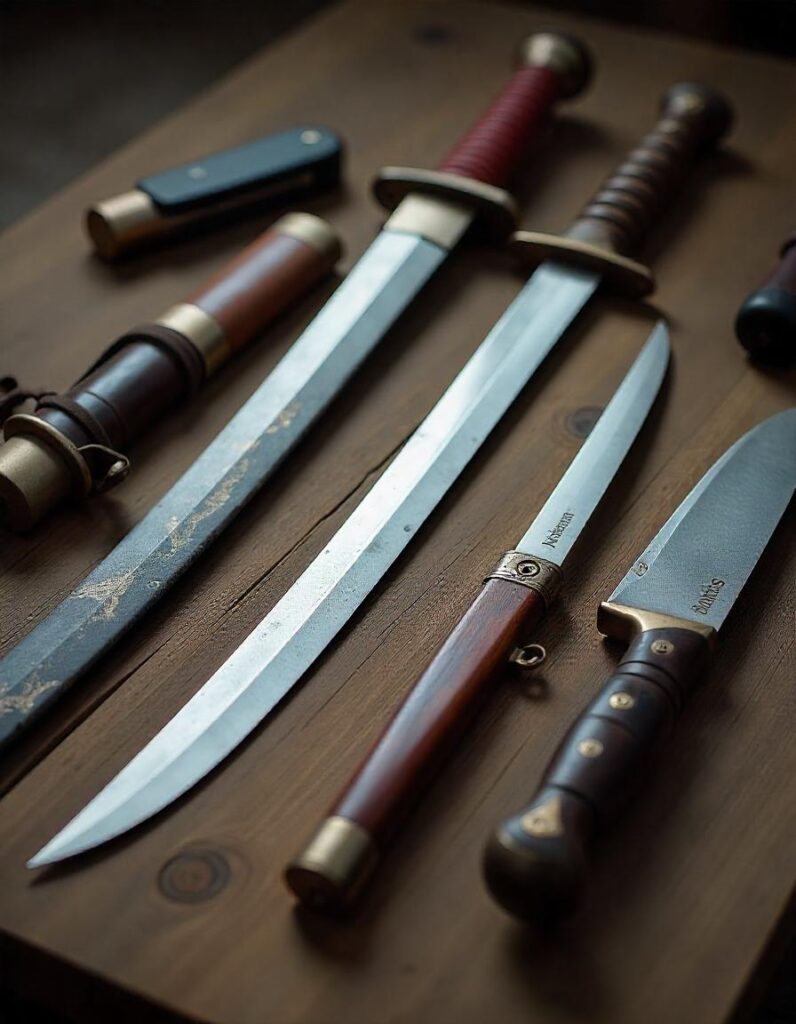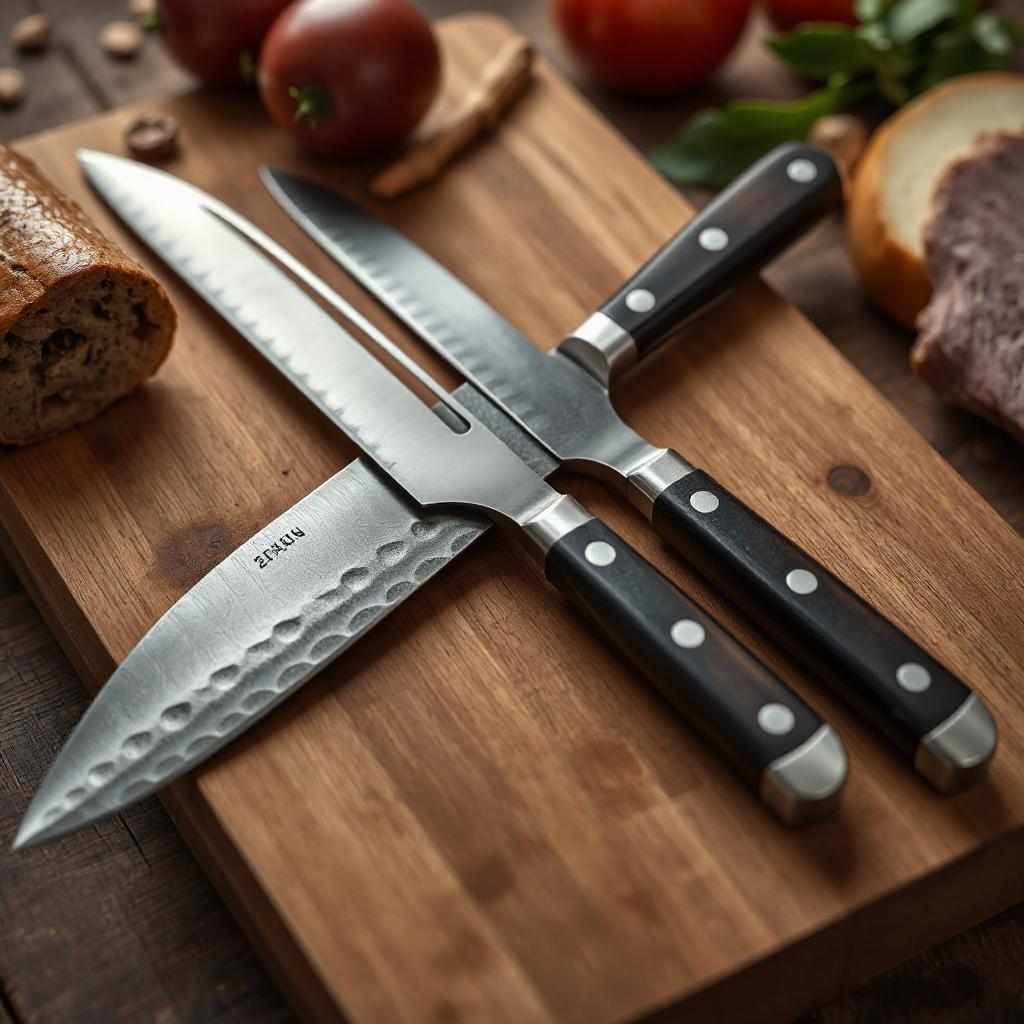I: History/Important Dates of Damascus Knives
Ancient swords crafted with precision inspire modern knife designs. Among the cutlers and collectors, Damascus knives have enjoyed respect over the ages. This Eastern practice has been easily identified with the Middle East region, for its strong textures and ornamental designs. Damascus was referred to as the destination of the country, where that special steel was shaped for the very first time. In the earlier days this steel was used for swords which were known to retain their sharpness and are very impact resistant.

Explanation of How is Steel Damask Produced
The technology of making steel of Damascus involves thick and thin iron sheets covered very well in different metals. A standard technique consists of raising a metal to a certain temperature, covering it in a napkin made of cloth, and kneading or rolling it over a knurl or some type of a cross. This concludes that such a blade displays the two-dimensional patterns that are pleasing to the earthly eye and are functionally active as well. In recent times advances have improved this method but the fundamental concepts of manufacturing Damascus steel has not changed. Ancient swords showcase the artistry that influences today’s culinary tools.
Importance of Damascus Knives in Both Ancient and Modern Times
It is notable that the Damascus knives of the ancient times were harkened enjoy simultaneously as arms and objects of prestige given their greater resilience and beautiful look patterns. Now they have a place among the knives that are used in the kitchen for their elegance cutting efficiency and durability. The process from arms into cutlery utensils goes on to show their relevance and usability in their various forms.
II. The Eating Knives and Swords Cutting Steel
Historical Significance of Damascus Steel in the Middle East
The Middle East’s forged weapons and Damascus steel have ancient people’s relation to each other. Ancient swords demonstrate the beauty of blended metals in knife making. In mid-eastern countries and regions, the culture of creating practical agents of destruction with ornamental elements was widely developed, and this culture indispensably included, and took this favorable light that emphasized the efficacy of the blades manufactured. This historical significance no doubt emphasizes the top grade of these steels.
Link Between Damascus Knives and Traditional Swords
Damascus knives and warmer swords the emphasis being gospel are also encoders of these former weapons. When it came to the production of kitchen knives, the artisans applied the very same technologies that gave rise to the maize of blades of legends without losing the standard. The change of swords to knives continues the mood of the story associated with these steels.

The Adoption of Damascus Knives Outside the Culture and Regions
With the establishment of trade routes, the technology of building up the Damascus steel moved to various meditative systems. This intercontinental progress brought Damascus knives in new markets and gave generation of different ranges of styles and practices. We have the beautiful mix of old world craftsmanship with present day designs of Damascus knives. Ancient swords exemplify craftsmanship that chefs admire and replicate.
III. History of development of Damascus Knives as utensils
Transition from Weapons to Kitchen Knives
This change of usage of the Damascus knives from being weapons to being kitchen utensils is a major development in the history of these tools. The same properties which made the Damascus steel ideal for swords- sharpness, robustness, and durability- were to turn out to be advantegeous to the usage of the knives. The glamour of this transition is that- the steel is multipurpose.
Advantages of Using Damascus Knives for Cooking
Whenever used in the kitchen, such cooking knives as Damascus knives have a myriad of pros. They are quite sharp which makes them appropriate for various functions including cutting, ranging from light vegetables to heavy meats in cooking style. Since knives are made of Damascus steel, the performance of the knives will not be compromised over a long period of time as the knives will be in constant use.
Increase in the Popularity with Professional and Amateur Chefs Alike
It can be stated that popularization of Damascus knives has been facilitated not only among the professional chefs, but also among the ordinary cooks as its functionalism is combined with beauty. Knives in this category impress by their performance and tend to be appreciated by those who have a whole different mentality as to the kitchen utensils and their quality.

IV. Modern Production Techniques
Traditional Methods vs. Modern Manufacturing Processes
Employing conventional procedures on producing Damascus steel would mean reverting back to some very back breaking and time consuming skills that most likely have been mastered over time and generations. What new technologies do is more productive, yet attempts to achieve the same level of quality skill as was provided by the older traditional procedures. These modern techniques enable the production of large numbers of quality Damascus utensils while still maintaining the features of the art. Ancient swords demonstrate the beauty of blended metals in knife making.
Reasons Affecting the Quality and Pricing of the Damascus Knives
With regards to the price of a cutlery knife and its expense factors such as the number of steel layers, applied materials and the cutters qualification have to be factored in. The higher the quality of Damascus knives the higher the extremely priced they have and this is no offense for them as knives endure the perfection in their purposes as tools. Therefore these circumstances enable buyers to know the reasons that co very high prices of Damascus knives.

Popular Brands and Artisans Famous for Making Damascus Knives
There are some brands as well as skilled craftsmen who are famous for their Damascus knives and swords paved with skills and precision. Ancient swords influence the aesthetics of modern culinary masterpieces of culinary knives. These include potters and other artisans and present-day producers who remain loyal to the decoration of Damascus steel. Knowledge-based exploration of these brands and artisans gives information about the best Damascus knife s on sale currently.
V. Care and Maintenance of Damascus Knives
Appropriate Storage Procedures to Guard against Destructive Situations
It is important to understand that recognizing and adhering to best practices for proper storage of Damascus knives will further enrich their appeal and use. The knives should be stored in an appropriate sheath or knife stand, away from other cutlery and utensils which may bump against the blade or cause blunt edges. Magnetic strips for knives are also very effective in ensuring that the knives are intact and don’t get damaged as well as maintaining neatness in the kitchen place.
Essential Cleaning and Sharpening Tips for Lasting Blades
In the case of knives, especially Damascus knives, a large chunk of the following proper maintenance advice would include the use of soap and water with colored explicit instruction handwashing, and then thoroughly dry in order to discourage rust. Periodic sharpening of the knife with a whetstone or honing rod is necessary due to the physical abrasions of the cutting activities over time with the douban. Do not use coarse cleansers or put the knife in a dishwasher to soak, as this could destruct the blade.

Maximize Performance with Consistent Servicing”
Damascus knives and swords require regular maintenance if they are to be preserved for a long time and used efficiently. Ancient swords lead to a revival of traditional techniques in modern kitchens. Solvent application is useful just to prevent rust, when periodic oiling with food grade mineral oil is done. On a related point, continual honing and sharpening of the blade characteristic makes this edge tool efficient. Proper maintenance ensures that the knife serves the kitchen for a long time as an efficient tool.
VI. Conclusion
Chronological Development of Australian Knives
The history and recent development of Damascus knives do justice to their popularity and superior quality. Over the years, the image of Japanese knives has transformed from that of weapons into that of kitchen utensils, and the reputation for quality and effectiveness has never been in decline.
Significance of Damascus Knives in Culinary World
Damascus knives are among those tools admired in the present culinary industry because of their practical use as well as artistic significance. They are an example of the knifemaking process and combine efficient features as well as ornamental factor
Damascus Knives: Elevate Your Culinary Experience
To people looking for high-end kitchen tools, using Damascus knives lets one appreciate what an exceptional quality kitchen knife feels like. It is a way of enjoying the art and practicality of a traditional tool by acquiring a Damascus knife.
FAQs
Here are five unique FAQs related to “Ancient Swords Influence Modern Culinary Masterpieces”:
How do ancient swords influence modern knife design?
Answer: Ancient swords influence modern knife design through their superior craftsmanship, ergonomic shapes, and unique blade patterns. Knife makers often study the techniques used in sword-making to enhance the performance and aesthetics of culinary knives.
What techniques from ancient sword-making are used in modern culinary tools?
Answer: Techniques such as folding and pattern-welding, common in ancient sword-making, are now employed in creating high-quality kitchen knives. These methods enhance the strength and sharpness of blades, making them more effective for culinary use.
Are there specific materials from ancient swords that modern knives utilize?
Answer: Yes, modern knives often use high-carbon steels reminiscent of those found in ancient swords. These materials provide durability and excellent edge retention, allowing chefs to achieve precision in their culinary tasks.
How do ancient swords contribute to the artistry of modern knives?
Answer: Ancient swords contribute to the artistry of modern knives by inspiring intricate designs and unique blade patterns. Many contemporary knife makers incorporate artistic elements drawn from historical swords, celebrating both function and beauty in their creations.
Why is understanding the history of ancient swords important for culinary professionals?
Answer: Understanding the history of ancient swords is important for culinary professionals as it deepens their appreciation for craftsmanship and the evolution of kitchen tools. This knowledge enhances their skills and inspires creativity in their culinary practices.
Summary
Ancient swords significantly influence modern culinary masterpieces by inspiring knife design and craftsmanship. The techniques used in sword-making, such as folding and pattern-welding, enhance the performance and aesthetics of contemporary kitchen knives. High-carbon steels, reminiscent of those used in ancient swords, provide durability and excellent edge retention. Additionally, the artistry of ancient blades inspires intricate designs in modern knives, merging functionality with beauty. Understanding this historical connection enriches culinary professionals’ skills and creativity, allowing them to appreciate the evolution of their essential tools.
